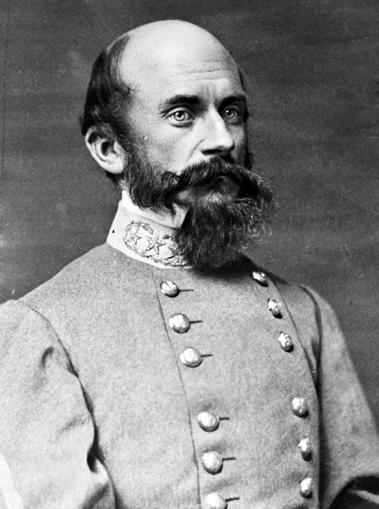Richard Ewell’s Leg?
Confederate Major General Richard Stoddard Ewell was bending down, trying to see below the musket smoke and setting sun.
The Battle of Groveton, one of the opening salvos in the Battle of Second Manassas had evolved into a stand-up, straight line, salvo by salvo firefight.
Ewell wanted to see the Union dispositions.
While kneeling, a Union minie bullet slammed into his left patella and seared down the leg. The ball had followed the the bone for six inches, which smashed the bone into multiple pieces.
Ewell yelped in pain.

As a veteran soldier, the Washington D.C. born-Virginia raised general knew the leg would have to be amputated. He even requested it. His soon to be stepson, Campbell Brown, found the general in obvious pain but still cognizant after dark.
Brown left to find litter and ambulance to escort Ewell from the field. While on his errand another litter squad found the general, placed him in the ambulance, and carried him off the field.
He arrived at the field hospital because of its close proximity to the front line, a second field hospital was found until that one came under Union fire.
By early the next morning, around 8:00 a.m., Ewell was moved to Auburn, over four miles from the battlefield. There the Buckner family, who owned Auburn, had 1,500 acres plus the accompanying slave dwellings.
This much of the wounding of Ewell is without reproof or debate.
At Auburn, the Confederate Second Corps chief surgeon, Dr. Hunter Holmes McGuire, did the surgery in the early afternoon. Ewell, under chloroform, had his left leg amputated right above the knee
Not the next part.
Local traditions recounted that the Confederates used the abandoned slave quarters on the property as their field hospital and inside one such dwelling Ewell’s leg was amputated.
However, according to Campbell Brown, Ewell was placed inside the main house and had his left leg amputated there.
After the limb was removed the questions, much like where the leg was taken off at, abound.
Once again, those local traditions and passed down stories claim that the Confederate general’s leg was hastily buried under a pile of rocks. However, Browns’ recollection claims that Ewell’s leg was disposed of in the corner of the Buckner garden by general’s servant, Jim Frame.
Although it is tempting to believe Brown’s accounts as he was a witness and would have many ties to Ewell; via his mother and in service to the Confederacy, historians cannot be too quick to credit just his account.
Many observers would have been around the field hospitals. Many accounts would have been shared, and local citizens would have had time to investigate.
Yet, nothing has surfaced and the story of where Ewell’s leg remains a mystery. Somewhere in western Loudoun County, Virginia, the left leg of one of the premier division commanders in the Army of Northern Virginia remains.

(Information from Ewell biography by Donald Pfanz)
Approximately 50 miles from where his former commander, Thomas Jonathan “Stonewall” Jackson’s left arm remains.
Approximately a week later Ewell was carried to Dunblane, the home of a relative to continue his recuperation. After showing the determination that made him an excellent field officer Ewell held onto life in the immediate aftermath of the amputation. By the fall he had traveled to the Allegheny Mountains where natural springs and the cooler air aided his recovery.
His final stop in his recuperation was in the Confederate capital in Richmond, Virginia where Lizinka Brown, Campbell’s mother, helped nurse the general back to health. Their love deepened from there.
A year later, Ewell would assume the mantle of leadership from the late “Stonewall” and march toward his perceived pivotal moment in his military career at a place called Gettysburg.
His leg remains at Auburn, somewhere.
* * *
*To learn more about Ewell and a source for this blog post, please consult Richard Ewell: A Soldier’s Life and The Letters of General Richard S. Ewell, written and edited, respectively, by Donald C. Pfanz.
interesting but needs corrections, Stonewall’s left army? for instance…
Thanks for reading with a keen eye and catching the typo. Glad you found the post interesting.
Many sources say that Dr. Farley, the surgeon of the 14th Brooklyn, amputated Ewell’s leg. This is the first I’ve seen another doctor credited with performing the operation.
Interesting…I’d never heard of Dr. Farley amputating Ewell’s leg. I’d always seen references to Dr. Hunter McGuire. I’ll have to check this a little more closely.
It’s in the 14th Brooklyn regimental history “The History of the Fighting Fourteenth.” They do get Ewell and Early mixed up, though.
Thanks for the source! I’ll have to look into this for my research on Dr. McGuire. It does seem that if it was Dr. Farley who operated on Ewell, this may be a case of a Union surgeon who was captured and yet was still working to save lives. It does seem a little odd that an officer with Ewell’s rank would’ve been turned him over to a captured doctor. However, it would not be impossible for Farley to have been working alongside Confederate surgeons, I guess. This is a real mystery and I’ll put it on my list of things to investigate. Thanks again for the info.
Reblogged this on Practically Historical.
Were bone fragments of Ewells leg mailed to Lizinka?
Yes. According to Campbell Brown, one of Ewell’s staff officers and eventual step son, fragments of the leg were mailed to Lizinka.